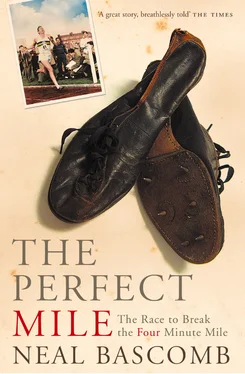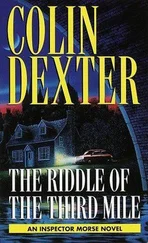Many wanted the bogey to go away, including the 1912 Olympic 1,500m champion Colonel Strode-Jackson, who wrote at the height of the Haegg–Andersson struggle, ‘When we stop this nonsense of running like a metronome and with the watch always in mind, we will get back to real racing, the triumph of one runner over another. That is what racing was meant to be and what it will be when we get the four-minute myth out of the way.’
Myth or not, twelve yards or many more, the barrier remained, and with each passing year, as runners attempted to break through its walls and failed, the mile barrier grew in notoriety. By 1952, as Frank Deford, one of the finest writers to report on the challenge, pointed out, ‘The Poles had been reached, the mouth of the Nile found, the deepest oceans marked, and the wildest jungles trekked, but the distance of the ground that measured a mile continued to resist all efforts to traverse it, on foot, in less than four minutes.’
The 1952 Olympic flame had barely been snuffed out in the Helsinki stadium when the editorials and reviews of the Games began to spin off the presses. Two points were indisputable: the Finns had proved to be fine hosts of the competition, and more records were broken in these Games than in any other Olympics in history.
Fewer than forty-eight hours after the closing ceremony in Helsinki, another competition was held, this time in London’s White City stadium, pitting a British Empire team against the United States. The stadium had staged an Olympic Games itself in 1908 and was infamous for setting the official marathon distance at 26 miles, 385 yards (instead of simply 26 miles) so that the race would finish in front of Queen Alexandra’s royal box. The stadium was now used for greyhound racing and an assortment of other events, including athletics. The Americans beat the British Empire team, as they had beaten the world a few short days before.
In the four-mile relay, where four runners from each team ran a mile, Roger Bannister earned the Empire team an early lead. But the second member of his team lost this advantage. Running third leg for the Americans, Wes Santee threatened to stretch out a lead for his team too great to overcome, but John Landy, running in the same leg for the Empire team, managed to close on Santee in the final 440. The anchors for each team traded leads, but in the end the Americans won. It was the first time Bannister, Santee, and Landy had competed in the same race. None of the three remembered much of the other, not a conversation, nor an impression of one another’s abilities. Yet as these three milers went their separate ways – Bannister back to life at St Mary’s Hospital, a short distance away by Tube, and Landy and Santee on long flights to their respective countries – each charted a course in the days ahead that would bring them back together again. It would be a struggle they and tens of millions would never forget.
Santee flew back with an American team flush with victory. Although the Soviets had fought well in their events and had, for a few days, looked like they might actually win the most medals, they hadn’t been able to match the strength of the United States track and field team, which won fourteen gold and thirteen silver and bronze. Among his team-mates, Santee was in the minority of those who did not medal. Watching the 1,500m final, knowing he had beaten the second-place finisher Bob McMillen ‘every time we had stepped on a track’, left him feeling empty and as helpless as a puppet. He was certain he could have won the race had he been given the chance the amateur officials had stolen from him in Los Angeles.
Before heading back to the University of Kansas, Santee went to visit his parents in Ashland for the first time since he had ridden away on that unnamed horse. If he was waiting for his father to say how proud he was of his son, Wes left empty-handed. Either his father simply didn’t understand what he had accomplished through his running, or the man just couldn’t express any feeling other than bitterness. Either way his silence stung. Over the past two years he had tried to convince his mother to leave his father, but she told Wes that since he had left his father had mended his ‘negative ways and stopped being so mean’. Regardless, Wes wanted nothing to do with the man.
Back in Lawrence, Santee sat down with Coach Easton, who did express his pride in Wes. Easton suggested he could learn a great deal from his Olympic experience, but Santee was less philosophical. It was not in his nature to suffer defeat. In his high school senior year he had lost the mile race in the state finals to Bill Tidwell. Although expected to win, particularly since he had in his sophomore and junior years, Santee had refused to be crestfallen. His close friend Don Humphreys had been surprised at his indifference. ‘I couldn’t understand how you could be up after losing the mile by a stride or two,’ he’d remarked to Wes. ‘I know Tidwell was a good distance runner, but it never occurred to me that he could beat you.’ Santee had explained in a matter-of-fact tone, ‘Oh, Tidwell, he’s not a miler.’ It took a while for Humphrey to understand this response. Then he thought of a football player who gets knocked down in a game and gets right back up and sets out to return the favour. Santee had that killer instinct. As Humphreys later said, ‘Guys like that never get whipped in their minds. Even when they get beat, they’re not beat.’
In Helsinki, Santee felt he had learned how to fend for himself and compete against the best. He wanted to prove what a big mistake it had been to prevent him from running in the 1,500m; more importantly, he also wanted to show how good he really was. He set his sights on a goal that had always been on the horizon for him: the four-minute mile. In the list of high-school prophecies published when he graduated was the following: ‘Wesley Santee has recently broke the world mile record in a time of 3 min., 58.3 sec. And it should stand for many years to come.’ Since his win at the Drake Relays the previous spring, the prediction by sportswriters that he was a sure bet for the world mile record had brought the goal closer in sight. His blistering three-quarter-mile run in New York before leaving for the Olympics had made him realise just how close. Only days after returning to campus, Santee marched into the office of the University of Kansas newspaper. He had an announcement to make: Wes Santee was going to be the first to run the four-minute mile. For years he had known he was capable. Now his intention was a matter of public record.
John Landy had a different announcement to make when he landed in Melbourne, but one just as telling. Directly after the British Empire versus United States match, he had boarded a flight to Australia. He had declined to join Macmillan and Perry, who, accompanied by Cerutty, were running in a series of competitions in Scandinavia. Landy needed to get back to his agricultural science studies, which had fallen by the wayside as a result of his efforts to make the Olympic team. And he wanted to start training again. Landy was determined to show that his trip to Helsinki had been worth the time and money it had taken to get him there. This desire to redress his failure to qualify in either of his events, a failure that had been met with what he believed was unwarranted criticism, was also woven into his excitement about the prospect of becoming a faster and stronger runner. He felt he had been given the lessons now – in terms of improving his stride and training methods – to reach this new level. Zatopek and other European middle-distance runners had shown him how.
For his stride, he would be helped by a pair of European track shoes he had bought. Landy wanted nothing more to do with the kangaroo-hide track shoes made in Melbourne, which were designed primarily for sprinting on grass tracks. Therefore, the spikes were built up in the front, so much so that it was awkward to lower the heel of the foot to the ground. They required him to run on his toes. In Helsinki, Landy noticed that the European middle-distancers ran in spikes with flat soles and a heel, and they had a smoother, more relaxed stride. But shoes alone would not change his running style; he would also have to practise the arm and leg action of the Europeans until it became habit.
Читать дальше












